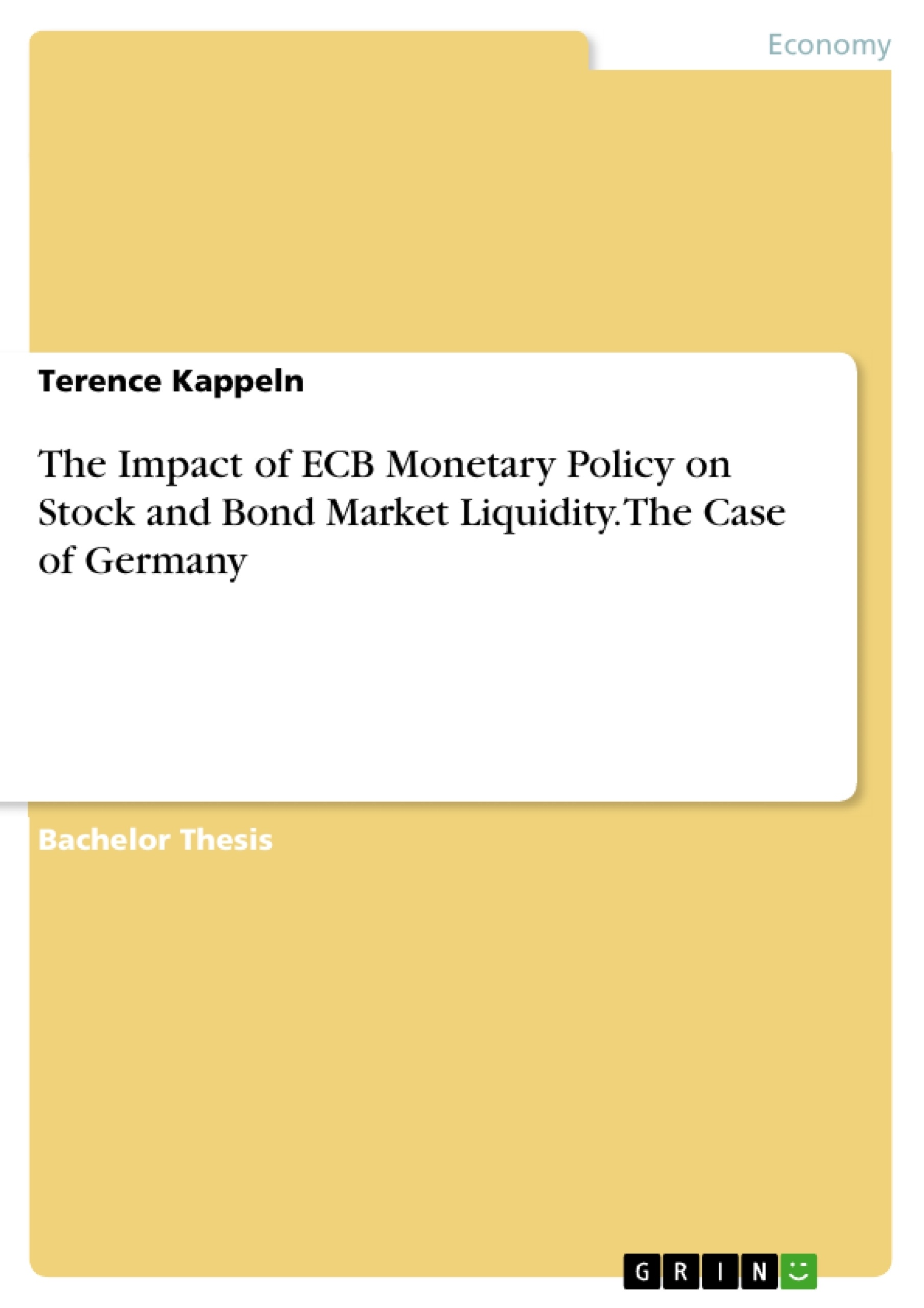During the financial crisis and the following Eurozone crisis, liquidity in financial markets basically froze and became a problem for the real economy. Therefore, market liquidity became one of the major concerns of the ECB, which applied non-standard measures, e.g. irregular asset purchasing programmes. This paper sheds light on the impact of monetary policy on liquidity levels of the DAX 30 equity index and German 10-year government bonds.
For the following analysis, the monetary policy impacts are estimated using the base money growth rate and EONIA rate, whereas the relative bid-ask spread is employed for measuring liquidity levels. The research method includes literature-based research about common market liquidity theories, a short timeline of important ECB monetary policy decisions, descriptive statistics on liquidity levels and monetary policy variables and a VAR analysis, including variables spreads, returns, volatilities, industrial production and inflation.
The results indicate that a decrease (increase) in stock market liquidity or an increase (decrease) in bondmarket volatility lead to a decrease (increase) of EONIA. Furthermore, decreases (increases) in stock return or industrial production result in a decrease (increase) of EONIA. However, base money growth is positively correlated only to changes in bond market volatility. Overall, the results suggest that the monetary policy decisions by the ECB are influenced by changing market conditions without the ability to forecast liquidity levels.
Inhaltsverzeichnis (Table of Contents)
- Introduction
- Theory
- Market Liquidity
- Stock and Bond Market Liquidity
- Market Liquidity Measures
- Monetary Policy and Market Liquidity
- Monetary Policy Measures
- Timeline of Monetary Policy Events
- Empirical Evidence
- Descriptive Statistics on Liquidity Levels
- Descriptive Statistics on ECB Monetary Policy Indictors
- Vector Autoregressive Analysis
- Conclusion
Zielsetzung und Themenschwerpunkte (Objectives and Key Themes)
This paper explores the relationship between European Central Bank (ECB) monetary policy and liquidity levels in the German stock and bond markets. It examines how changes in key monetary policy variables, such as the EONIA interest rate and base money growth, impact the bid-ask spreads of the DAX 30 equity index and 10-year German government bonds.
- The impact of ECB monetary policy on market liquidity.
- The role of market volatility in influencing liquidity levels.
- The relationship between stock and bond market liquidity.
- The influence of economic variables such as stock returns and industrial production on liquidity.
- The effectiveness of ECB monetary policy in managing liquidity.
Zusammenfassung der Kapitel (Chapter Summaries)
The paper begins by defining market liquidity and outlining its various dimensions. It then discusses the theoretical relationship between monetary policy and market liquidity, drawing on existing literature. A timeline of key ECB monetary policy decisions from 2008 onwards is presented to highlight the evolution of their response to the financial crisis and subsequent Eurozone crisis.
The empirical analysis investigates the impact of monetary policy on liquidity levels by examining descriptive statistics for liquidity measures and ECB policy variables. A vector autoregressive (VAR) analysis is then conducted to further examine the relationship between endogenous variables, such as stock spreads, bond spreads, base money growth, and EONIA, and exogenous variables such as stock and bond market returns and volatility, industrial production, and inflation.
Schlüsselwörter (Keywords)
The paper focuses on the impact of ECB monetary policy on market liquidity, particularly in the German stock and bond markets. Key terms include: market liquidity, bid-ask spread, EONIA interest rate, base money growth, volatility, stock returns, industrial production, and VAR analysis. The research explores the theoretical connections between these concepts, providing insights into the mechanisms through which monetary policy affects market liquidity and the role of various economic factors in shaping market conditions.
- Citation du texte
- Terence Kappeln (Auteur), 2015, The Impact of ECB Monetary Policy on Stock and Bond Market Liquidity. The Case of Germany, Munich, GRIN Verlag, https://www.grin.com/document/313683



